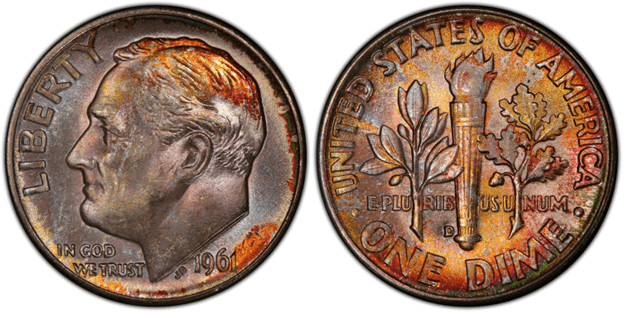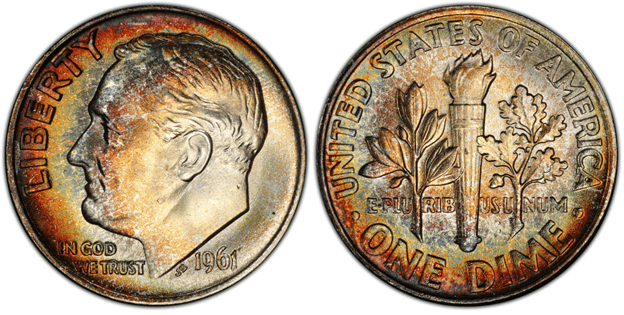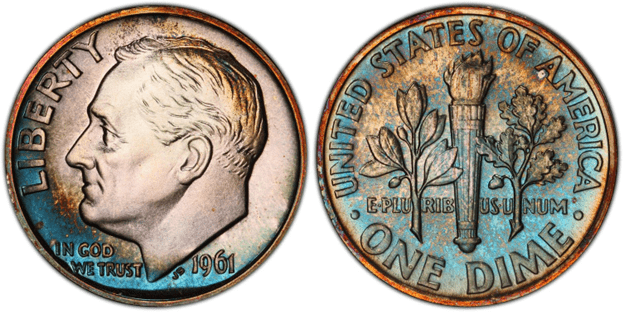What Is the 1961 Roosevelt Dime Made Of?
The 1961 Roosevelt dime is composed of 90 percent silver and 10 percent copper. The Roosevelt dime was first issued in 1946. At that time, it was made of silver and copper. This continued until 1964. The dime then became cupronickel.
Nevertheless, the U.S. Mint once again produced silver Roosevelt dime from 1992 to 2018. Only this time, the silver dimes were made for collectors and not for general circulation.
To give you more idea, here are the specifications of the 1961 Roosevelt dime:
- Value – 10 cents
- Diameter – 17.91 mm
- Mass – 2.50 g
- Edge – reeded
As its name suggests, the 1961 Roosevelt dime features the bust of Franklin Delano Roosevelt (FDR), the 32nd president of the United States. Upon his death in 1945, Congress moved to add his image to the dime. The dime was chosen because of Roosevelt’s huge role in starting the March of Dime.
Creating the design wasn’t that easy. The Mint’s chief engraver, John Sinnock, needed to repeatedly revise his design until the Commission of Fine Arts approved the final version. From there, the design of Sinnock remained essentially the same to this day.
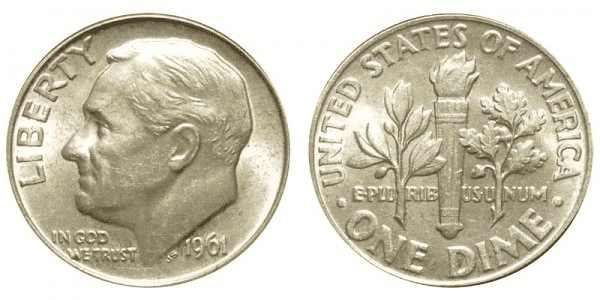
When it comes to the design, the obverse has Roosevelt’s image. The inscriptions include the following:
- LIBERTY
- IN GOD WE TRUST
- 1961
- Designer’s initials (JS)
On the reverse side, there are three primary images that you’ll find: the liberty torch, olive branch, and oak branch.
The inscriptions include the following:
- UNITED STATES oF AMERICA
- E PLURIBUS UNUM
- ONE DIME
The word dime came from the Old French word, disme, which became dime in Modern French. The word means tithe or tenth part.
1961 Roosevelt Dime Varieties
The 1961 Roosevelt dime has at least three varieties. These are the 1961-D, 1961-P, and 1961 Proof Roosevelt dimes. Aside from these standard-issued coins, some error coins give rise to a new variety. At the end of 1961, there were more than 305,904,794 10-cent coins struck by the U.S. Mint.
To learn more, here are the 1961 Roosevelt Dime Varieties:
1961 D Roosevelt Dime
Year of minting: 1961
Mint Mark: D
Place of minting: Denver
Quantity produced: 209,146,550
Face Value: $0.10 (one cent)
Price: $0.10 to $10 (or more)
Mass: 2.50 grams
Edge: Reeded
Designer: John Sinnock
Composition: 90% Silver, 10% Copper
Diameter: 17.91 mm
Thickness: 1.35 mm

photo source: PCGS
The Denver Mint produced the most number of Roosevelt dimes in 1961. There were more than 93.7 million 1961 D Roosevelt dime coins produced. You can sell these coins from $0.10 to $10, depending on the rarity and condition of the coin.
1961 P Roosevelt Dime
Year of minting: 1961
Mint Mark: No mint mark
Place of minting: Philadelphia
Quantity produced: 93,730,000
Face Value: $0.10 (one cent)
Price: $0.10 to $13 (or more)
Mass: 2.50 grams
Edge: Reeded
Designer: John Sinnock
Composition: 90% Silver, 10% Copper
Diameter: 17.91 mm
Thickness: 1.35 mm

photo source: PCGS
The Philadelphia Mint produced 93,730,000 Roosevelt dimes in 1961. You can sell these coins from $0.10 to $13 or even more, especially when you sell them in the open market.
1961 P Roosevelt Dime (Proof)
Year of minting: 1961
Mint Mark: No mint mark
Place of minting: Philadelphia
Quantity produced: 3,028,244
Face Value: $0.10 (one cent)
Price: $1 to $11 (or more)
Mass: 2.50 grams
Edge: Reeded
Designer: John Sinnock
Composition: 90% Silver, 10% Copper
Diameter: 17.91 mm
Thickness: 1.35 mm

photo source: PCGS
Aside from the standard coins, the Philadelphia Mint also produced more than 3 million proofs of 1961 dime coins.
Since proof coins are made for collectors, the quantity is not that big. Proof coins are shinier and more detailed. Because it takes more time and effort to produce proof coins, they are the fewest variety in the 1961 dime series.
The price starts at around $1 to $11. If your proof coin is still in good condition, it doesn’t have any blemish or scratch, then the price can easily go up to the hundreds.
List of 1961 Roosevelt Dime Errors
As mentioned, there are more than 305 million 1961 Roosevelt dimes. So, it should not be surprising to see some of these coins having minting errors.
There were different dime errors in 1961. Here are some of them:
- Broad-strike error – happened when the coin wasn’t held properly in its place. When the die hit the coin, the coin flattened and broadened.
- Off-center strike error – happened when the die struck the coin at the wrong angle.
- Doubled die – may happen on the obverse or reverse. The die hit the coin twice, causing the coin to have to double in the engraved elements.
- Clipped or folded planchet – the coin wasn’t shaped properly, and its edge might have been clipped or folded.
- Lamination error – when different materials get into the mixture of the planchet. When the planchet cooled down, the coin cracked.
Here’s an example of a 1961 Roosevelt dime error:

Here’s an example of a clipped coin:
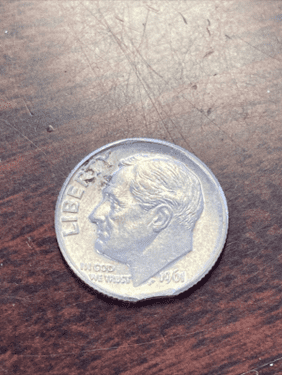
How Much Is 1961 Roosevelt Dime Worth Today?
The 1961 Roosevelt dime has a face value of $0.10. Its melt value is higher since it is made of silver. The melt value is $1.5452. You might think that the 1961 dime is too cheap. However, you might be surprised to know that some of these dimes are worth a hundred to a thousand dollars.
Here’s a 1961 Roosevelt Dime values chart to help you better understand its pricing:
| Coin | Condition | Grade | Mintage | Value |
| 1961 D Roosevelt Dime | Circulated/mint | Not graded | 209,146,550 | $0.10 to $10 |
| 1961 D Roosevelt Dime | Uncirculated/mint | MS-66 | 209,146,550 | $10 to $35 |
| 1961 D Roosevelt Dime | Uncirculated/mint | MS-67 | 209,146,550 | $21 to $345 |
| 1961 D Roosevelt Dime | Uncirculated/mint | MS-68 | 209,146,550 | $1,610 |
| 1961 no mint mark Roosevelt Dime | Circulated/mint
|
Not graded
|
93,730,000 | $0.10 to $13 |
| 1961 no mint mark Roosevelt Dime | Uncirculated/mint
|
MS-65 | 93,730,000 | $8 to $13 |
| 1961 no mint mark Roosevelt Dime | Uncirculated/mint
|
MS-66 | 93,730,000 | $10 to $70 |
| 1961 no mint mark Roosevelt Dime | Uncirculated/mint
|
MS-67 | 93,730,000 | $20 to $127 |
| 1961 no mint mark Roosevelt Dime (Proof) | Uncirculated/mint
|
Not graded
|
3,028,244 | $0.10 to $11 |
| 1961 no mint mark Roosevelt Dime (Proof) | Uncirculated/mint
|
PR-68 | 3,028,244 | $11 to $30 |
| 1961 no mint mark Roosevelt Dime (Proof) | Uncirculated/mint
|
PR-69 | 3,028,244 | $17 to $52 |
| 1961 no mint mark Roosevelt Dime (Proof) | Uncirculated/mint
|
PR-70 | 3,028,244 | $153 to $336 |
As you can see, some 1961 dimes are worth a lot of money. Just to show you how much some people have earned from these coins, here are some examples.
An MS-68 1961 D dime was sold for $1,610 on September 11, 2009, during an auction held by the Heritage Auctions. According to PCGS, the auction record for the 1961-P dime is $550. Last, the auction record of the 1961-P-proof coin is $396.
How Does The Grading System Work?
The Sheldon Scale is used by numismatists to provide a numerical value to coins. The Sheldon Scale goes from poor (P-1) to perfect mint state (P-1) (MS-70). Coins were originally evaluated using words to reflect their condition (Good, Fair, Excellent, Etc.). Unfortunately, coin collectors and dealers had different ideas about what each of these terms represent.
Professional numismatists joined together in the 1970s and established CoinGrading standards. These numismatists now assign grades at key places on the seventy-point scale, using the most regularly utilized numeric points in conjunction with the original adjective grade. The following are the most common coin grades:
-
-
- (P-1) Poor – Indistinguishable and probably damaged; if used, must have a date and mintmark; otherwise, rather battered.
- (FR-2) Fair – Nearly smooth, but without the damage that a coin graded Poor often possesses. The coin must have enough detail to be identified.
- (G-4) Fair – Inscriptions have merged into the rims in some areas, and important elements have been mostly erased.
- (VG-8) Very Good- A little weathered, but all of the primary design elements are visible, albeit faintly. There is little if any, central detail left.
- (F-12) Good – The item is very worn, yet the wear is even, and the overall design details stand out clearly. Rims are almost completely isolated from the field.
- (VF-20) Very Fine – Moderately weathered, with some finer features still visible. The motto or all letters of LIBERTY are readable. Both sides of the coin have entire rims that are separated from the field.
- (EF-40) Extremely Fine – Gently used; all gadgets are visible, and the most important ones are bold. The finer details are bold and clear, however, light wear may be seen.
- (AU-50) Uncirculated – Slight evidence of wear on the coin’s design’s high points; may have contact marks; eye appeal should be adequate.
- (AU-58) Uncirculated Choice – Slight traces of wear, no severe contact marks, almost full mint shine, and great eye appeal.
- (MS-60) Mint State Basal – Strictly uncirculated; no indication of wear on the coin’s highest points, but an unsightly coin with reduced luster, visible contact marks, hairlines, and other flaws.
- (MS-63) Mint State Acceptable – Uncirculated, but with contact scratches and nicks, little reduced shine, but otherwise appealing appearance. The strike is weak to average.
- (MS-65) Mint State Choice – Uncirculated with great mint shine, very little contact blemishes, and exceptional eye appeal. The strike is unusually severe.
- (MS-68) Mint State Premium Quality – Uncirculated with superb luster, no obvious contact marks to the naked eye, and exceptional eye appeal. The strike is quick and appealing.
- (MS-69) Almost Perfect Mint State – Uncirculated with perfect brilliance, a sharp and appealing strike, and extremely good eye appeal. A near-perfect coin with minor imperfections in the planchet, strike, and contact markings (seen only under 8x magnification).
- (MS-70) Mint State Perfect – Under 8x magnification, there are no tiny imperfections discernible; the strike is crisp, and the coin is perfectly centered on a beautiful planchet. Rarely seen on a coin, this coin is bright and whole, with original luster and exceptional eye appeal.
-
Where To Buy Or Sell 1961 Roosevelt Dime?
There are different places where you can buy and sell 1961 Roosevelt dimes. The quickest way is through the Internet. A simple Google search such as “buy 1961 Roosevelt dime” or “sell 1961 Roosevelt dime” should give you hundreds of useful websites.
If searching the Internet is not your thing, you can visit Amazon and eBay. These online marketplaces are known to attract a lot of sellers and buyers of Roosevelt dimes. So, there’s a good chance you’ll find your needed coin here.
Of course, there are other places that you should note. For example, coin shops, pawnshops, and antique stores would be good choices. You can check them out and see if you can sell or buy coins from them.
FAQs
What percentage of silver is in a 1961 dime?
The 1961 dime has 90% silver, and the rest is made of copper.
Is there a 1961-d Roosevelt Dime with a clipped error?
There is a 1961-D Roosevelt dime with a clipped error. One example is found on eBay. It is being sold for $10.
What to look for in a 1961 Roosevelt dime?
If you’re curious about where the 1961 dime was struck, you must look at the mint mark. The mint mark is found at the base of the torch. If you find a small letter D, it means the dime is from the Denver Mint. If you don’t find any mint mark, it means the dime is from the Philadelphia Mint.

